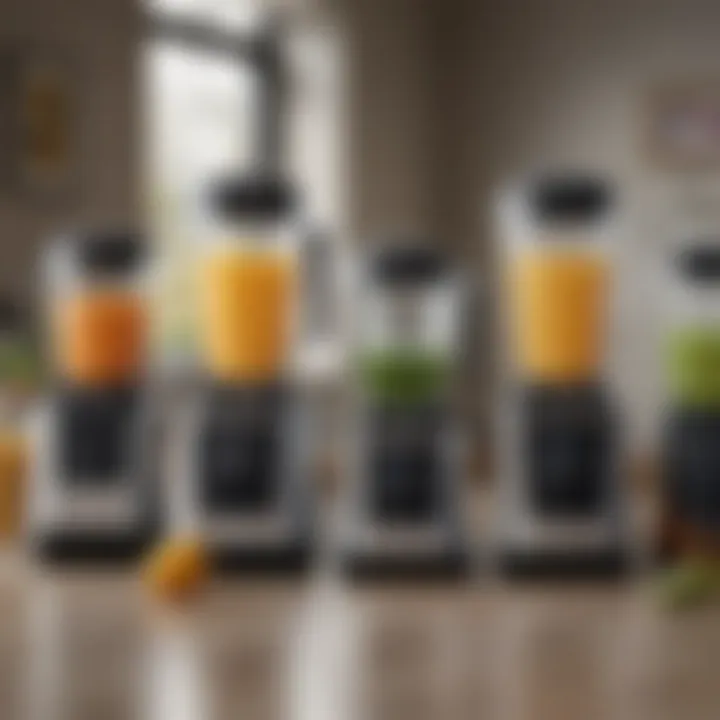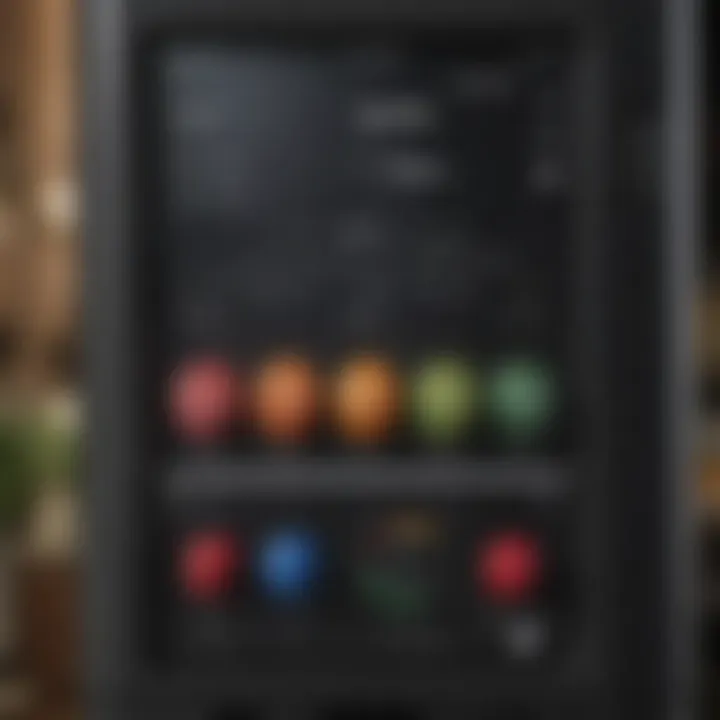Selecting the Best Blender for Smoothies


Intro
Selecting the right blender can greatly influence your smoothie experience. A powerful blender not only reduces preparation time but also enhances the texture and quality of your smoothies. In this guide, we will delve into crucial factors to consider, the types of blenders available, and important specifications that directly affect performance. Furthermore, we will share maintenance tips to maximize the life of your blender while comparing popular brands and their unique offerings.
Understanding what makes a blender effective for smoothies requires knowledge of various features, such as motor power, blade design, and jar materials. Each component plays a significant role in producing a blend that meets your taste and texture preferences.
This guide aims to cater to both beginners looking to improve their smoothie-making skills and culinary enthusiasts seeking the best blending solutions. By examining essential qualities and specifications, readers will gain insights into selecting a blender that truly meets their needs.
Understanding the Purpose of a Blender
When considering the importance of a blender, especially for smoothies, it's essential to appreciate its fundamental role in the kitchen. A blender can transform basic ingredients into a smooth and cohesive drink. This process not only enhances flavor but also makes it easier for the body to absorb nutrients. For those aiming to maintain a healthy lifestyle or simply enjoy a variety of beverages, understanding how a blender operates is crucial.
Defining the Role of a Blender in Smoothie Preparation
A blender serves as the backbone of smoothie preparation. Its ability to homogenize various ingredients ranging from fruits and vegetables to yogurt and liquids cannot be overstated. When used correctly, a blender breaks down solid components, allowing for a silky texture that is not just appealing but also nutritious. The vibrations and spped from the blender create a swirling motion, ensuring that every part of the mixture is evenly processed.
The nutritional benefits rise significantly when you use a blender rather than eating the individual components separately. Smoothies allow for the combination of different vitamins and minerals from multiple sources.
Difference Between Food Processors and Blenders
Understanding the distinction between a food processor and a blender is vital when selecting the right appliance for smoothies. While both tools can chop and blend, their functionalities differ in critical ways:
- Blenders focus on liquidizing and emulsifying ingredients. They excel in creating smooth textures necessary for smoothies and soups.
- Food processors, on the other hand, are designed for chopping, slicing, and shredding. They are more suited to heavier tasks like making dough or slicing vegetables.
In essence, to make the perfect smooth smoothie, investing in a high-quality blender will always yield better results than using a food processor. The type of blades, jar shape, and motor strength all affect the performance, making blenders more suitable for this specific purpose.
"Choosing the right appliance can mean the difference between a chunky mess and a smooth, enjoyable smoothie. Blenders are purpose-built for this task."
Key Features of a Strong Blender
When it comes to selecting a strong blender for smoothies, understanding the key features is vital. A blender is more than just an appliance; it plays a central role in determining the texture, consistency, and overall quality of your smoothie. Selecting a blender equipped with the right features can enhance your blending experience and ensure your investment serves well for many years.
Motor Power and Its Importance
Motor power is one of the most critical specifications to consider in a blender. Measured in watts, a more powerful motor usually equates to more efficient and effective blending. A blender with at least 600 watts is ideal for smoothies, especially when blending tougher ingredients like frozen fruits or leafy greens. Higher wattage ensures that the motor can maintain speed and torque under load, resulting in smoother textures and less strain on the appliance.
Furthermore, a robust motor allows for quicker blending, which can retain more nutrients in your ingredients. It's important also to consider that a blender with adequate power will minimize wear and tear, leading to better longevity over time.
Blade Design and Material
The blade is another integral feature that impacts blending quality. A well-designed blade can effectively break down ingredients and create a smooth consistency. Look for blades made from stainless steel or high-quality materials. These are not only more durable but also sharper, which is essential for efficient blending.
Different blade designs can create varied results. For instance, a cross blade design is typically effective for chopping and mixing, while a single blade may perform better for specific tasks like pureeing. Consider whether the design complements your intended use when making your choice.
Jar Capacity and Material Options
When choosing a blender, the jar capacity is a practical consideration. Blenders come in various sizes, so selecting one that aligns with your typical batch size is essential. For single servings, a smaller jar may suffice, but larger families or those making big batch smoothies may benefit more from larger jars, usually around 64 ounces.
The material of the jar also matters. Glass jars are heavy and can be more difficult to handle but are generally more resistant to scratches and can be cleaned easily. Plastic jars are lighter and often come with shatter-resistant properties but may not last as long with heavy use. Assess your lifestyle and choose accordingly.
Speed Settings and Control Features
Speed settings can significantly influence the blending process. A blender with multiple speed settings allows for greater control over the blending texture. If you want a smoothie with varied thickness, having options for adjusting the speed can enhance that flexibility.
Some blenders also come equipped with pulse features. This can be particularly useful for controlling the texture, allowing you to create chunky or finely blended smoothies as desired. Look for models that also feature pre-programmed settings for specific tasks, which can simplify the blending process further.
Ease of Cleaning and Maintenance Considerations
Cleaning can often be overlooked but is a crucial aspect of blender use. An efficient blender should have components designed for easy disassembly for thorough cleaning. Many modern blenders have self-cleaning features, which can save time and make maintenance fuss-free.
Additionally, users should ensure to review the durability of parts that are prone to wear, like gaskets or seals. A blender that requires less maintenance and offers easy cleaning methods will prove to be more user-friendly in the long run. Regular maintenance extends the lifespan and functionality of the product, providing better performance with each use.


Types of Blenders Suitable for Smoothies
When considering the right equipment for smoothie preparation, understanding the types of blenders available is crucial. Each type caters to different needs, preferences, and lifestyle choices. By selecting the right blender, one can enhance the smoothie-making experience, achieving specific textures and consistencies. Here we will explore three common types: countertop blenders, immersion blenders, and personal blenders.
Countertop Blenders
Countertop blenders are often regarded as the workhorses of smoothie preparation. They typically come with a robust motor and a larger jar capacity, enabling them to handle a variety of ingredients, from soft fruits to tougher leafy greens. The benefits of a countertop blender include:
- Power: Most countertop blenders come with powerful motors, often exceeding 1000 watts, which is essential for pulverizing ingredients to a smooth consistency.
- Versatility: They can handle a wide range of tasks beyond smoothies, including soups, sauces, and even nut butters.
- Capacity: They usually offer larger jar sizes, making them suitable for preparing smoothies for multiple servings at once.
However, they can take up significant kitchen counter space and may be difficult to clean.
Immersion Blenders
Immersion blenders, also known as stick blenders, present a different approach to blending. They are handheld devices that allow for blending directly in the container where the ingredients are placed. Their advantages include:
- Convenience: Immersion blenders are lightweight and easy to handle. They make it simple to blend ingredients in various containers, including pots and cups.
- Easy Cleanup: Since they are often used in the same containers where ingredients are mixed, cleaning is generally simpler, requiring just a quick rinse of the blending stick.
- Space-Saving: They do not require much storage space, making them ideal for smaller kitchens.
Despite these benefits, they may not produce the same smooth texture as a countertop blender, particularly with tougher ingredients or larger volumes.
Personal Blenders
Personal blenders have gained popularity due to their compact size and user-friendly designs. They typically consist of a blending base and a detachable jar that doubles as a travel cup. The key features of personal blenders include:
- Portability: Many personal blenders are designed for on-the-go individuals. They allow users to blend and carry smoothies in the same container.
- Simplicity: They usually come with a one-button operation, making them easy to use for anyone.
- Energy Efficient: Often, they come with lower wattage motors, which are sufficient for basic smoothie tasks and consume less energy.
However, users may find that personal blenders have limited capacity and may struggle with tough or fibrous ingredients.
Selecting the right type of blender depends on individual preferences and needs. Factors such as space, lifestyle, and frequency of use should inform this decision. Understanding these different offerings will make the path to finding a suitable blender much clearer.
Comparing Popular Blender Brands
When investing in a blender, it is critical to examine the brand's reputation and reliability. Different brands offer various features tailored to specific needs. Understanding these nuances helps users make well-informed choices. Additionally, comparing popular brands gives insights into product quality, design innovations, and customer support. It is crucial to consider factors such as warranty, price-to-value ratio, and customer reviews before making a purchase decision.
Vitamix: A Leader in High-Performance Blenders
Vitamix is widely recognized in the blending community for its powerful performance and durability. Known for designing high-end blenders, Vitamix products often come with robust motors, making them capable of handling tough ingredients without sacrificing smoothness.
Some standout features of Vitamix blenders include:
- Variable speed control: This allows users to adjust the blending process precisely, achieving the desired consistency.
- Self-cleaning settings: With just a drop of soap and warm water, users can clean the jar quickly.
- Durable construction: Most Vitamix models are built with high-quality materials designed to last for years.
Despite the premium price, the benefits often outweigh the cost, especially for frequent smoothie consumers looking for the best results.
Ninja: Versatile and Affordable Options
Ninja has established itself as a go-to brand for those seeking budget-friendly yet versatile kitchen appliances. Their blenders cater to a wide demographic, from casual users to health enthusiasts. Ninja models are designed with powerful motors that can efficiently blend various types of ingredients.
Key features of Ninja blenders include:
- Multiple functions: Many Ninja models can perform tasks beyond blending, such as chopping, mixing, and even food processing.
- Compact design for small spaces: Ideal for home kitchens with limited counter space.
- Easy assembly and cleaning: Components are user-friendly and usually dishwasher safe, simplifying the cleaning process.
Ninja products provide excellent value for money and are perfect for those who want flexibility without breaking the bank.
Blendtec: Innovative Technology and Design
Blendtec is renowned for its innovative approach to blending technology. Their blenders often incorporate advanced features, making the blending experience more efficient and enjoyable. Key traits of Blendtec blenders include:
- Smart blending technology: Blendtec uses sensor technology to optimize blending times and power based on the ingredients.
- Preprogrammed settings: Users can select different programs tailored for specific types of blends, such as smoothies, soups, and frozen desserts.
- Stylish designs: Blendtec often focuses on aesthetics, making their products appealing for modern kitchens.
For those who prioritize cutting-edge technology in their kitchen gadgets, Blendtec presents a compelling option.


Oster: Value for Everyday Use
Oster is a reputable brand known for its reliable and effective blenders at reasonable prices. Their products often strike a balance between cost and functionality, making them suitable for casual kitchen users. Some valuable features of Oster blenders include:
- Wide range of models: Oster provides various models catering to different blending needs and budgets.
- Durable glass jars: Many Oster blenders include glass jars that are resistant to scratches and odors, providing longevity.
- Easy operation: Their blenders typically have simple settings that make them accessible even for beginners.
Oster remains an excellent option for those looking to make smoothies without investing in high-end appliances.
Assessing Blending Performance
Assessing blending performance is vital for anyone looking to invest in a blender for smoothies. Smoothie blending is not just about mixing ingredients; it is about achieving the right consistency, flavor distribution, and texture. The performance of the blender can significantly affect the final result.
When you select a blender, consider its ability to achieve a uniform mixture. This means all ingredients, whether fruits, vegetables, or seeds, should integrate smoothly. A poorly performing blender can leave chunks of unblended items, leading to an unpleasant texture and an unsatisfactory experience. The blending capability ensures that nutrients are fully released and readily absorbable, enhancing the health benefits of the smoothie. Therefore, evaluating the blending performance is not merely an operational detail, but a critical aspect that impacts the overall quality of your smoothie.
Reviewing Smoothie Consistency and Texture
The texture of a smoothie defines its quality. A strong blender should create a velvety and seamless drink. Smoothies should not have graininess or large pieces. You can judge the performance of a blender by the consistency it can produce. A high-quality appliance can blend fibrous vegetables and frozen fruits into a creamy mix.
The importance of texture cannot be overstated. It plays a critical role in the enjoyment of the drink. A smoothie with a pleasant texture can elevate the experience, making it more enjoyable and palatable.
To evaluate consistency:
- Conduct Smoothness Tests: Blend various ingredients and observe the time taken. Fast and effective blending with a smooth outcome indicates good performance.
- Watch for Separation: A well-blended smoothie should hold its consistency without layering or splitting after a short period.
Noise Levels During Operation
Noise is another performance aspect to consider when choosing a blender. While many high-performance blenders produce significant sound during operation, the level of noise can be daunting in a quiet kitchen environment. Some blenders, such as Vitamix, have designed quieter models that reduce operational sound while maintaining power.
Understanding the noise levels is essential for lifestyle compatibility. For those blending in the morning while others rest or in an open kitchen, a quieter choice can be beneficial. Noise can also indicate the efficiency of the motor and the quality of components used.
When evaluating the noise:
- Test Before You Buy: If possible, always test the blender in-store. This allows you to assess if the sound is acceptable to you.
- Consider a Sound Enclosure: Some brands offer blenders with built-in noise reduction systems, which can be a practical investment for home users.
Assessing a blender's performance features will lead to a better overall smoothie-making experience. Consider how well it achieves consistency and how acceptable the noise levels are.
User Considerations When Choosing a Blender
When selecting a blender for smoothies, there are practical user considerations that significantly influence the decision-making process. Understanding these factors ensures that users select a blender that meets their specific needs, provides value for their investment, and enhances their overall smoothie-making experience. These considerations often lead to a more satisfactory long-term relationship with the chosen appliance.
The first aspect to consider is the budget. Establishing financial limits can help narrow options early in the search. Blenders exist across a broad price range, with less expensive models meeting basic needs, while high-end options offer advanced features and durability. Prioritizing essential features over brand names can lead to better value as well. Choosing a blender that fits within your budget, yet offers important functionalities, is vital.
Another factor to keep in mind is the lifestyle and frequency of use. For frequent smoothie drinkers, a robust blender with superior motor power is essential to handle daily blending tasks effortlessly. On the other hand, infrequent users might opt for a more affordable model without advanced features, as they may not utilize the blender to its full potential. This differential can affect both the initial decision and the long-term enjoyment of the appliance.
Regular users might experience better satisfaction with high-performance blenders.
In summary, considering both the budget and lifestyle is crucial for making an informed choice. These elements help identify a blender that fits personal usage patterns while ensuring that the appliance meets both expectations and financial constraints.
Budget and Investment Considerations
Budget plays a key role in the selection process. It goes beyond just the initial purchase price. Think about the long-term cost of ownership, including potential repairs and replacements. Blenders with better build quality and warranties can save money over time. Mid-range options can often provide the best balance between functionality and expense.
Investing in a high-quality blender could translate to improved performance, resulting in smoother textures and quicker blending times. Budgeting should also take into account possible upgrades in the future. Evaluating the price relative to anticipated usage can yield insights into whether a more expensive model is a reasonable step.
Lifestyle and Frequency of Use
Understanding your lifestyle is critical. If smoothies are a key part of your daily routine, selecting a powerful blender becomes essential. Frequent use demands a model that can withstand heavy blending without wear. Also, consider the types of smoothies you prefer to make.
If you enjoy experimenting with fibrous ingredients like kale or frozen fruits, a strong motor and effective blade design can make a significant difference. For occasional users, convenience might take precedence over advanced features. A compact, user-friendly blender may be the right choice then.
By clarifying both budget and lifestyle, you can successfully navigate the array of choices available, arriving at a solution tailored specifically to your needs.


Best Practices for Creating Smoothies
Creating the perfect smoothie involves more than just throwing together some fruits and liquids in a blender. Understanding the best practices can significantly enhance both the taste and nutritional value of the smoothie. Implementing these practices allows for a more consistent texture, better flavor melding, and maximizes the health benefits of your ingredients. Whether you are a beginner or experienced in smoothie preparation, paying attention to ingredient selection and blending techniques is crucial.
Selecting Ingredients for Nutritional Balance
Selecting the right ingredients is paramount for achieving a harmonious and nutritious smoothie. A well-balanced smoothie combines fruits, vegetables, proteins, and healthy fats to provide a comprehensive range of nutrients. Here are some fundamental considerations for ingredient selection:
- Fruits: Opt for a variety of fruits to add natural sweetness and flavor. Bananas, berries, and mangoes work well together.
- Vegetables: Dark leafy greens, such as spinach or kale, can be included for added vitamins and minerals without altering the taste significantly.
- Proteins: Adding a scoop of protein powder, Greek yogurt, or nut butter can enhance satiety and support muscle health.
- Healthy Fats: Incorporate options like flaxseeds, chia seeds, or avocado to promote heart health.
- Liquids: Use almond milk, coconut water, or even plain water as a base. They can improve consistency while adding minimal calories.
The aim is to create a smoothie that feels complete and offers a nutritional punch. Understanding the role of each ingredient can help in crafting smoothies that sustain energy levels throughout the day.
The Order of Ingredients for Optimal Blending
The order of adding ingredients matters in achieving a smooth and consistent blend. This helps in ensuring that all components are blended evenly and reduces the chances of any ingredient getting stuck. Here’s a helpful guideline on the order to follow:
- Liquids first: Start with your chosen liquid to allow other ingredients to move freely.
- Soft ingredients: Add soft fruits like bananas or yogurt next, which help in creating a smoother consistency.
- Greens: Follow with the leafy greens; they will blend better when integrated with the soft ingredients first.
- Hard fruits/vegetables: Next, add tougher ingredients like apples or carrots.
- Seeds and nuts: Include flaxseeds, chia seeds, or nuts for added health benefits.
- Powders last: If using supplements or protein powders, add them last to ensure they are evenly distributed during blending.
Following this order will lead to a better blend, minimize chunks, and enhance the overall texture of your smoothie, thus optimizing the experience.
Maintenance and Care of Your Blender
Maintaining and caring for your blender is essential for maximizing its lifespan and ensuring optimal performance. A well-cared-for blender not only functions better but also delivers consistent results for your smoothies. Regular maintenance can prevent wear and tear, which can lead to costly repairs or replacements. It is crucial to follow specific cleaning guidelines and troubleshooting techniques to keep your blender running smoothly. Understanding how to maintain your appliance will enhance its utility and value in your kitchen.
Cleaning Methods and Recommendations
A clean blender is vital for hygiene and efficiency. After each use, proper cleaning will prevent residue buildup and unwanted odors. Here are effective cleaning methods:
- Immediate Rinse: After blending, rinse the container with warm water right away. This helps to remove most ingredients and prevents them from drying onto the blades.
- Use of Soap and Water: Fill the blender jar halfway with warm water and add a few drops of dish soap. Secure the lid and blend on high for about 30 seconds. Rinse thoroughly with clean water.
- Deep Cleaning: For stubborn stains or odors, create a mixture of water and white vinegar. Blend this solution and let it sit for a few minutes before rinsing it out.
- Disassembly for Deep Cleaning: Some blenders allow for the user to remove blades and seals. If this is possible, ensure these parts are cleaned separately to avoid any buildup of food particles.
- Avoiding Damage: Always check manufacturer instructions regarding cleaning. Some metals or plastics may require special care to prevent scratches or deterioration.
Troubleshooting Common Issues
Even with proper care, blenders can experience problems. Knowing how to troubleshoot common issues can save time and prevent frustration. Here are some potential problems and solutions:
- Blender Won't Turn On:
- Unusual Noises:
- Inconsistent Blending:
- Leaking:
- Check if it is plugged in securely.
- Ensure that the lid is properly secured as many blenders have safety features that prevent operation without a lid.
- Inspect any reset button on the base.
- Unusual sounds can be a sign of jarring components. Check for any loose parts or food stuck in the blades.
- Listen for abnormal noises when blending; they may indicate a problem with the motor.
- Ensure that ingredients are cut into uniform pieces for best results. Large chunks can cause uneven blending.
- When adding more solid ingredients, add some liquid to facilitate smoother blending.
- Leaks typically stem from worn out seals. Check and replace seals if necessary.
- Ensure the jar is secured properly on the base.
Regular maintenance and care will not only extend your blender’s life but also enhance your overall smoothie-making experience.
Following these cleaning and troubleshooting tips will keep your blender in top shape, allowing you to create delicious and nutritious smoothies with ease.
Culmination: The Path to Smoothie Mastery
In the journey towards creating the perfect smoothie, selecting the appropriate blender serves as a foundational step. A strong blender is not merely an appliance; it is an investment in health and culinary creativity. This section synthesizes the key insights from prior discussions, emphasizing the critical factors to consider when making a decision. Look into the motor power, blade design, and jar capacity. Understanding these elements helps potential buyers grasp how they impact blending performance. Additionally, considering user needs, budget constraints, and lifestyle choices is equally essential. A seamless experience relies on a gadget that aligns with one’s unique demands, ensuring that smoothie preparation remains efficient and enjoyable.
"Selecting the right blender is the key to unlocking the full potential of your smoothie creations."
Summary of Key Factors in Selecting a Blender
When choosing a blender for smoothies, several factors demand attention:
- Motor Power: Opt for a model with adequate wattage to ensure smooth blending of tough ingredients.
- Blade Design: High-quality blades made from stainless steel enhance the blending process, offering durability and efficiency.
- Jar Capacity: Depending on the quantity you plan to blend, select a jar size that fulfills your needs.
- Speed Settings: Adjustable speed options allow for better control, particularly when dealing with diverse ingredients.
- Ease of Cleaning: A design that facilitates effortless cleaning will save time and effort post preparation.
These factors contribute significantly to the effectiveness and satisfaction of the smoothie-making experience, and they should guide consumers in their purchasing decisions.
Future Trends in Blender Technology
As consumers become more health-conscious and creative in the kitchen, blender technology continues to evolve. Several trends are emerging:
- Smart Features: Many blenders are incorporating smart technology, enabling app connectivity for customized recipes and monitoring.
- Energy Efficiency: New models are aiming for lower power consumption while maintaining performance, appealing to those who prioritize sustainability.
- Enhanced Self-Cleaning Options: Future designs may offer more advanced self-cleaning mechanisms, saving users time without compromising hygiene.
- Multi-functional Devices: Blenders are increasingly blending capabilities with other kitchen appliances, providing versatility for culinary enthusiasts.
These innovations point to a future where blending is not only simpler but also more efficient and integrated into daily life.



